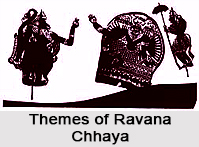 Themes of Ravana Chhaya centre exclusively on the legends and myths of Lord Rama. For the purposes of the Ravana Chhaya, there is no written plat which is used. It is contained completely in the oral tradition. However, it uses the lyrics from Vichitra Ramayana written by Viswanath Khuntia, a medieval Oriya poet. Impromptu prose-dialogue plays an important role in the presentational style. The spoken word material, though mostly colloquial and marked for its spontaneity, owes much to the various forms of Rama literature in Oriya language.
Themes of Ravana Chhaya centre exclusively on the legends and myths of Lord Rama. For the purposes of the Ravana Chhaya, there is no written plat which is used. It is contained completely in the oral tradition. However, it uses the lyrics from Vichitra Ramayana written by Viswanath Khuntia, a medieval Oriya poet. Impromptu prose-dialogue plays an important role in the presentational style. The spoken word material, though mostly colloquial and marked for its spontaneity, owes much to the various forms of Rama literature in Oriya language.
Orissa has a strong Ramayana tradition, especially in the field of literature. While there are only 3 to 4 versions of Mahabharata, more than 50 versions of Ramayana are found in Oriya, out of which about half a dozen are of the lyrical variety, which to be sung and acted. The most celebrated of these lyrical forms is the Vichitra Ramayana of Viswanath Khuntia and Nata Ramayana of Kesava Pattanayaka. Kesava`s rendering makes an enchanting jatra. Thus it is clear that Ramayana has very much influenced the traditional theatre of Orissa. Viswanath Khuntia was a resident of Puri, which is famous for the temple of Lord Jagannath. He composed Vichitra Ramayana during the rule of Raja Dibyasingha Deva from 1692 to 1720 A.D. The towering poets of his time are Dina-krushna and Upendra Bhanja, and the latter is prefixed with the title of Kavi Samrat which means the Emperor of Poets. Both of them wrote highly ornate poetry, which shows excellent craftsmanship with remarkable diction and the unrestrained use of shringar rasa. In the age of such complex and elaborate poetry-writing, Viswanath Khuntia chose to write in a completely different style which is simple, colloquial and with no stress on erotic symbolism. Yet he is as lyrical as his contemporary poets.
In terms of its central theme, the Vichitra Ramayana has not departed much from the original Sanskrit language Ramayana except for identifying Rama with Lord Jagannath of Puri. In the beginning there is an interesting description of the Ratha Yatra (Car-festival) of Puri. This aspect, however, is not reflected in Ravana Chhaya, which proves that the shadow-theatre originating centuries before, adopted it like the human theatre forms of the-region, because of its lyrical character and easy adaptability to dramatic froms.
Vichitra Ramayana, which is now available in print contains 289 chandas (cantos). Scholars are of the opinion that Viswanath composed only 237 chandas and the rest 52 are interpolations. The poet has indicated raaga and tala for some of the chandas. Raagas often used in this work are: Kamodi, Mukhari, Madhukari, Bhatiari etc. and talas: Sarimana, Padi, Pata etc. All these are peculiar to the Odissi School of Classical Music. Many chandas, although indicated to be sung in a particular raaga and tala often are sung to traditional tunes that do not follow the indication of the poet. In Ravana Chhaya the chandas of Vichitra Ramayana are sung in traditional tunes, which have a more folk character and therefore match the style of presentation.
Vichitra Ramayana became so popular that it found a following in the works of some later poets like Raja Vikram Narendra, Ananga Narendra, Shaibya Sadashiva and Ishwaradas. These and other language Ramayanas are the source from which the spoken material for the performance of Ravana Chhaya is drawn.




















